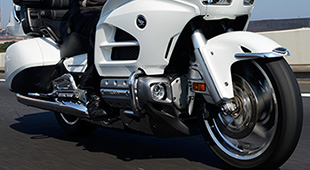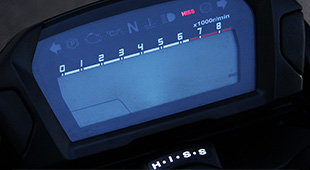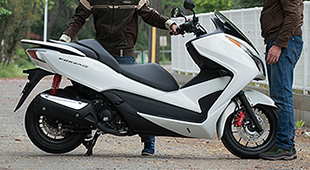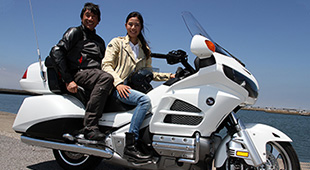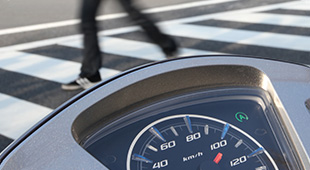Tech Views — Vol.10 Flangeless & Titanium Fuel Tanks
Flangeless Fuel Tank (1/2)
Do You Know How Much Work Goes Into Making Honda’s Fuel Tanks?
In this chapter, I want to talk about fuel tanks — the part affectionately known by many motorcycle lovers as ‘the tank.’
This important component is often regarded as the ‘face’ of the motorcycle, and its shape, size and color are often considered determining factors in one’s first impressions of a bike’s design. Of course, the main function of the fuel tank is simply to hold fuel. However, it also provides a secure area for the knees to grip while riding, acting as an important point of contact between bike and rider. And when cleaning and polishing it on days not out riding, the tank can also be an object of affection that fosters a rider’s close relationship with his or her machine.
When thinking about fuel tanks, I’m sure I’m not the only one who’s been entranced by or taken pictures of the reflections seen in its curvaceous surface. Such memories leave an indelible impression, like fleeting delights that enrich our motorcycling lives.
Some fuel tanks, notably those of scooters, are located under floorboards. Others, as in the case of the Super Cub, and even the Gold Wing, are positioned under the seat, However, today we’re going to focus on the fuel tanks mounted on sports bikes.
Recently, Honda has been making news regarding its fuel tanks. For the CB1100EX and RS models, it has adopted a clean, new flangeless tank design that’s made using a highly evolved production process and featuring a unique coating method that incorporates deeply embossed figurative art design. This, I realized, came about as a result of the long pursuit of a sense of ownership and cool looks.
The CRF450R is an off-road only motocross machine, while the CBR1000RR SP/SP2 is a high-performance sports bike. Both are outfitted with titanium fuel tanks. Titanium is widely associated with lightness, and in the world of custom parts, it is often used in the manufacture of mufflers and exhaust pipes, and titanium bolts are also widely available. The image we have of titanium is that it is light in weight, thus providing a shortcut to high performance, but that it’s also quite expensive.
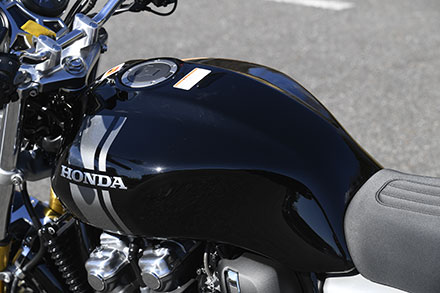
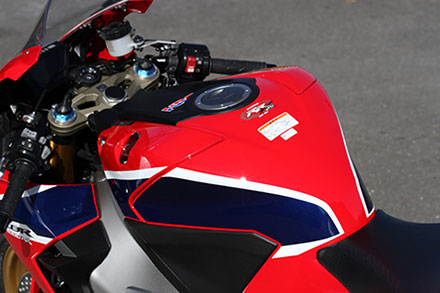
In my opinion, sports bikes are the most engaging and pleasure-oriented forms of mobility there is. That, above all, is why a sleek fuel tank endowed with a cool appearance and light maneuverability deepens one’s love for a particular riding machine while enhancing one’s satisfaction when actually riding it. And when these two points mesh well with a rider’s personal tastes and preferences, there are no better characteristics of performance. Cool looks may seem like useless embellishments, but material lightness and strength are best suited to the pursuit of high performance.
On this point, it’s my firm belief that Honda’s strength is rooted in manufacturing techniques that give us pleasure and delight.
However, in earlier reporting I found that flangeless tanks are not really well suited to mass production, because they require a significantly more complicated manufacturing process.
Similarly, titanium is used to make the specialized components used in racing machines and other limited production cars and bikes. However, it is not the sort of material that can be easily used in the manufacture of fuel tanks for general production motorcycles.
I figured the best thing to do would be to talk to the people who actually make the bikes. So, I flew down to Kumamoto to visit Honda’s factory there, which is the company’s global center for the manufacture of motorcycles and fuel tanks.
Not only is this Honda’s center for manufacturing motorcycles, but following the partial relocation to Kumamoto in 2011 of Honda’s Motorcycle R&D Center, which designs sports bikes and the like, this has become an important facility that carries out both the ‘creation’ and ‘production’ of motorcycles in the same location.
As a result, design and production staff perform their jobs while constantly cooperating and sharing information, making it possible to speed up work and collaborate quickly on solving problems as they arise. In such an environment, relations of trust that transcend boundaries are formed, and the motivation to make exciting new products is greatly enhanced.
I’m convinced that such synergy has imparted a broad range of solutions to the important job of manufacturing fuel tanks.
Understanding Honda’s Pride in Its Tanks
I’m reminded of the words of a Honda engineer I recently talked to: “There are no merely functional parts visible on a motorcycle. Every part is ‘seen’ as an element of its overall design and appearance.”
A prime example of this is the fuel tank, and Honda takes special pride in the fuel tanks that it makes.
Before we can discuss the individuality of certain motorcycles, it is first necessary to consider the vital function of safety. Since the fuel tank is tasked with carrying gasoline, any kind of leakage can quickly lead to potentially disastrous secondary damage. Honda also takes pride in the research it has directed at preventing problems from occurring.
Honda conducts motorcycle collision safety testing in the same way it does for cars. Collision tests aimed at building safer chassis and fuel tanks. Making sure that, among many things, the rider’s clothes don’t catch on the fuel cap during a collision, possibly causing it to open, or that the force of a collision doesn’t deform the tank in ways that could cause fuel to leak, and so forth.
Moreover, to ensure that customers can enjoy their products over long years with complete peace of mind, Honda strives to build reliability into all of its fuel tank designs. For example, when mounting the tank on the frame, rubber bushings are used as damping material to absorb engine and road surface vibration.
Considerable know-how is also devoted to ensuring reliability, even down to the size of the bolts and the shape of the collars used to secure the tank. In other words, thanks to the sophisticated technology that is channeled into such otherwise unseen areas, we riders are able to lovingly hug our tanks with complete peace of mind.
Having explained the basic elements of Honda’s fuel tanks, it’s now time to report on the main theme of tank manufacturing.
In Part 1, we’ll look into the ‘flangeless’ tank design used for the CB1100EX/RS, while in Part 2 we’ll introduce the titanium fuel tanks used on the CRF450R motorcrosser and the CBR1000RR SP/SP2 superbike.
- TOP
- Flangeless Fuel Tank
- Titanium Fuel Tank

